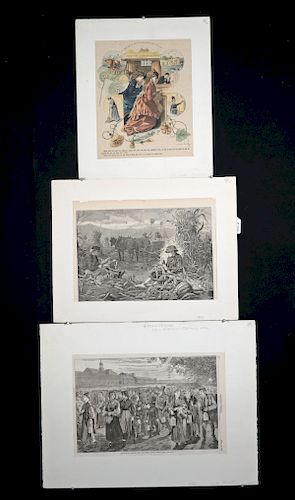Three 19th c. Winslow Homer Engravings
Lot 367
About Seller
Artemis Gallery
686 S Taylor Ave, Ste 106
Louisville, CO 80027
United States
Selling antiquities, ancient and ethnographic art online since 1993, Artemis Gallery specializes in Classical Antiquities (Egyptian, Greek, Roman, Near Eastern), Asian, Pre-Columbian, African / Tribal / Oceanographic art. Our extensive inventory includes pottery, stone, metal, wood, glass and textil...Read more
Categories
Estimate:
$600 - $900
Absentee vs Live bid
Two ways to bid:
- Leave a max absentee bid and the platform will bid on your behalf up to your maximum bid during the live auction.
- Bid live during the auction and your bids will be submitted real-time to the auctioneer.
Bid Increments
| Price | Bid Increment |
|---|---|
| $0 | $25 |
| $300 | $50 |
| $1,000 | $100 |
| $2,000 | $250 |
| $5,000 | $500 |
| $10,000 | $1,000 |
| $20,000 | $2,500 |
| $50,000 | $5,000 |
| $100,000 | $10,000 |
| $200,000 | $20,000 |
About Auction
By Artemis Gallery
Jan 7, 2020
Set Reminder
2020-01-07 10:00:00
2020-01-07 10:00:00
America/New_York
Bidsquare
Bidsquare : VARIETY AUCTION - Antiquities / Ethnographic
https://www.bidsquare.com/auctions/artemis-gallery/variety-auction---antiquities-ethnographic-4787
Around the world & back in time - be amazed at the treasures you will find. Antiquities from Egypt, Greece, Italy and the Near East, Asian, Pre-Columbian, African / Tribal / Oceanic, Native American, Spanish Colonial, Russian Icons, Fine Art, much more! Artemis Gallery info@artemisgallery.com
Around the world & back in time - be amazed at the treasures you will find. Antiquities from Egypt, Greece, Italy and the Near East, Asian, Pre-Columbian, African / Tribal / Oceanic, Native American, Spanish Colonial, Russian Icons, Fine Art, much more! Artemis Gallery info@artemisgallery.com
- Lot Description
**Originally Listed At $300**
Winslow Homer (American, 1836-1910), three wood engravings from Harper's Weekly including "Tenth Commandment" from "Harper's Weekly", March 12, 1870, p. 161. Inscribed "Winslow Homer" at the lower right. At the upper center in plate: HAVE MERCY UPON US AND INCLINE OUR HEARTS TO KEEP THIS LAW. / TENTH COMMANDMENT; across bottom: "Thou shalt not covet thy neighbor's house, thou shalt not covet thy neighbor's, nor his servant, nor his maid, nor his ox. / or his ass, n or any thing that is his." / " Lord, have mercy upon us, and write all these laws in our hearts, we beseech thee." Size: largest 13.875" W x 9.25" H (35.2 cm x 23.5 cm); 21" W x 16.25" H (53.3 cm x 41.3 cm) with mat
Next is Winslow Homer's "NEW ENGLAND FACTORY LIFE - 'BELL-TIME'" from Harper's Weekly July 25, 1868, p. 472. This engraving is also in the Smithsonian American Art Museum collection. The Smithsonian's exhibition label reads, "In 1868, Winslow Homer took up the subject of people who worked in textile mills. Mill operatives’ activities were organized by bells that rang throughout the day. Before mid-century, Americans viewed factories as places where respectable folk—mostly women—could earn a decent income and make a contribution to the nation’s industrial transformation. By the time Homer created his picture, native-born farmwives and their daughters had long been absent from the mills. Recent immigrants and the desperately poor replaced them at the looms, the only takers for work that offered the barest sustenance." (https://americanart.si.edu/artwork/new-england-factory-life-bell-time-harpers-weekly-july-251868-37013)
Finally, Homer's "THE LAST DAYS OF HARVEST" from Harper's Weekly December 6, 1873, p. 1093. Homer's late summer to early fall scene includes two boys shucking corn in the foreground and two men using pitchforks to load pumpkins on a horse drawn wagon in the background. Philip Beam writes, "There is a noticeable fondness for the activities of boys and girls who seem to play far more than they work" and he includes this engraving among Homer's examples of scenes of rural life which follow that pattern. Scholar Gordon Hendricks in his "The Life and Work of Winslow Homer" states that Homer based this composition on a sketch from a visit to the White Mountains of New Hampshire in 1868.
A Winslow Homer is best known for masterful paintings such as "Prisoners from the Front" (1866), "The Veteran in a New Field" (1865), "Snap the Whip" (1872), and "The Gulf Stream" (1899). However, earlier in his career, Homer was a printmaker in Boston and New York. At the age of nineteen, Homer apprenticed to J.H. Bufford of Boston. His long career as an illustrator for "Harper's Weekly" spanned from the late 1850's to the mid 1870's.
Provenance: private Lucille Lucas collection, Crested Butte, Colorado, USA
All items legal to buy/sell under U.S. Statute covering cultural patrimony Code 2600, CHAPTER 14, and are guaranteed to be as described or your money back.
A Certificate of Authenticity will accompany all winning bids.
We ship worldwide and handle all shipping in-house for your convenience.
#133934These engravings are set in mats which show some age wear. "The Last Days of Harvest" has a couple of small tears at the upper center of the engraving, a foxing stain in the sky, and a tear to the lower right of mat. Otherwise engravings appear in fairly good condition with slight toning as expected.Condition
- Shipping Info
-
All shipping is handled in-house for your convenience. Your invoice from Artemis Gallery will include shipping calculation instructions. If in doubt, please inquire BEFORE bidding for estimated shipping costs for individual items.
-
- Buyer's Premium



 EUR
EUR CAD
CAD AUD
AUD GBP
GBP MXN
MXN HKD
HKD CNY
CNY MYR
MYR SEK
SEK SGD
SGD CHF
CHF THB
THB


















